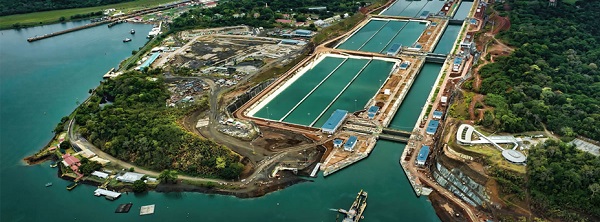
Ever wish you could own a toll booth? Imagine you stand there while everyone who passes hands you a hundred dollars, a steady stream of Benjamins with a long line of travelers waiting to pass through.
Now imagine that every time someone paid to get by, they handed over $54,000. Not bad. But your booth is narrow. Not everyone can fit through. So you invest in an expansion.
There are a few hiccups and when you are done, there are a few critics. But, at the end of the day, you’ve tripled the size of your toll booth. The first one to go through your bigger passage pays you $575,000. Wow. More pass every day each paying big bucks. Just a few days later, a particularly huge one comes along. They hand over $829,000 to get by. You smile and say to the throng waiting in line… “Next!” This is Panama today.
The Panama Canal has been a major contributor to Panama’s economy. Even if the projections of the expanded Panama Canal provided by the Canal Authority of prove to be overstated, the expansion’s economic impact will be outstanding. “The government estimates that fiscal transfers from the Canal will increase 45% starting in 2017 and that investment in related infrastructure such as ports will increase by 40% in the medium term. In a special report assessing the impact of the expanded Canal, Fitch Ratings said that increased earnings from the Canal offer a unique opportunity for the government to reduce public debt levels and consolidate its fiscal position. The agency noted that a credit rate hike could take place if the government achieves the two aforementioned points.”
Related infrastructure? The Canal tolls are just a part of the revenue stream. The expansion enhances Panama’s prime position as a global value-added logistics hub. Think liquefied natural gas terminals, new transshipment hub facilities, expanded ports and the like … projects already underway or imminent which will inevitability multiply the economic benefits of the expansion.
Panama Canal expansion tolls are now pouring in…There are less than 4 million people in Panama. The Canal expansion and its accompanying profit centers will inevitably dramatically impact economic growth and development. There are also many other factors outside of the Canal contributing to Panama’s rapid growth. Panama’s finest days are just beginning.

Excerpts from July 12, 2016 report on Panama from Focus Economics, Economic Forecasts from the World’s Leading Economists
“…the opening of the expanded Panama Canal on 26 June guarantees that the economy will be resilient. The government estimates that fiscal transfers from the Canal will increase 45% starting in 2017 and that investment in related infrastructure such as ports will increase by 40% in the medium term. In a special report assessing the impact of the expanded Canal, Fitch Ratings said that increased earnings from the Canal offer a unique opportunity for the government to reduce public debt levels and consolidate its fiscal position. The agency noted that a credit rate hike could take place if the government achieves the two aforementioned points.”
“Expansion of the Panama Canal has been a major source of economic activity since the project began in 2007. Estimated at a cost of USD 5.5 billion, the construction of wider locks and deeper channels will allow for passage of larger container freight ships, help the canal remain competitive in the realm of global trade and therefore sustain toll revenues. Other large public spending infrastructure projects have also driven economic growth in recent years and solidified Panama’s standing as a major logistical hub in the region. This includes the building of a metro line in Panama City, which was inaugurated in April 2014 and is the first in Central America, as well as a new metrobus system, an improved highway network and enhancements to Tocumen International Airport.”
“The economy of Panama is centered on a highly-developed services sector, which represents more than 75% of gross domestic product (GDP). The Panama Canal and use of the U.S. dollar have promoted the strengthening of a globally-oriented services economy. The Panama Canal is essential to global trade and accounts for almost 10% of the country’s GDP.”
More: Panama Leads Latin and Central American Economic Growth By Far
Containership Pays Nearly $1 Million Toll to Cross the Expanded Panama Canal
gCaption, July 5, 2016 by Mike Schuler
“With the opening of the Panama Canal expansion in June, it was to be expected that the waterway would shatter all sorts of cargo volume records, but with the canal’s added capacity one figure in particular stands out: $829,468.
That’s the staggering toll a containership previously too big to use the Panama Canal just paid to pass through it.
The toll was paid by the Mitsui O.S.K. Lines-operated MOL Benefactor for a northbound transit of the canal on July 1, 2016, the Panama Canal Authority has confirmed. The previous toll record was paid by the COSCO Shipping Panama for its inaugural transit of expanded locks to the tune of $575,545.
In fact, the 10,000 TEU MOL Benefactor was actually the first neopanamax containership to use the new locks since commercial operations began June 27, so the transit offers a glimpse of what is likely to come in terms of toll revenue.
The ACP said as of June 30 a total of 174 vessel has booked slots to transit the Panama Canal’s neopanamax locks, although it did not disclose how many of those were specifically neopanamax containerships.
The ACP sets tolls for containerships based on vessel size and TEUs, so assuming containerships with a cargo capacity of up to 13,000 TEU begin using the canal as expected, it seems like it’s only a matter of time before we see the first million dollar transit of the Panama Canal.”
Panama Canal’s 2015 revenues 8 pct. above budget forecast – Agencia EFE
Panama Canal Expansion: A Potential Supply-Chain Game-Changer
Forbes, July 23, 2016, by Harold Sirkin
“Many investors, public and private alike, are making big bets on U.S. infrastructure projects tied to expansion of the Panama Canal, which started moving supersized container ships through its wider, deeper channel and locks on June 26.
The canal’s expansion was years in the making and cost a reported $5.25 billion. But that’s a fraction of what’s being spent here in the United States to make East and Gulf Coast ports accessible to the giant ships now able to pass through the canal.
The opening of the expanded canal will have a ripple effect on the economy – impacting not only U.S. ports and shipping, but the railroad and trucking industries as well, along with virtually every company involved in trade with Asia, or manufacturing or sourcing from Asia. Overall, according to research conducted by BCG and the transportation and logistics firm, C. H. Robinson, as much as 10% of container traffic between East Asia and the U.S. could shift from West Coast ports to East Coast ports by the year 2020.
This doesn’t mean West Coast ports will see a decline in shipping traffic. It means the West Coast ports, many of them already operating at or near capacity, will see traffic increase more slowly than they might otherwise.
Supply chain managers may have the toughest jobs of all. They will have to balance the relative value of time and cost, calculations that can be fraught with uncertainty. It’ll be slower, but cheaper – perhaps as much as 30% cheaper in some cases – to ship certain goods from East Asia to the East Coast. It’s a tradeoff that will be well worth making in some cases, but not others, as the research referenced above explains.
The savings that manufacturers, shippers, retailers and consumers may realize from the new routing patterns will need to be balanced, of course, against the bill taxpayers are being handed to deepen East Coast harbors and shipping channels and upgrade port facilities.
The Port Authority of New York and New Jersey – which oversees the largest East Coast port complex – will spend nearly $3 billion alone, if current estimates hold. Some $1.3 billion will be spent to raise the height of the Bayonne Bridge, which connects Staten Island, N.Y. and Bayonne, N.J. This will allow the bigger ships to pass under the bridge so they can get to the docks for loading and unloading. Another $1.6 billion will be spent deepening the harbor and shipping channel.
The South Carolina Ports Authority will spend a reported $1 billion through the end of the decade on dredging and other capital improvements at the Port of Charleston. When the work is done, Charleston harbor will be the deepest on the East Coast, they say. Another $4.5 billion will be spent on a new container terminal in Jasper County, S.C., adjacent to the Port of Savannah, a joint project with the state of Georgia.
Upstate South Carolina, where the state’s “inland port” is located – some 200 miles from Charleston, near Greenville – also expects to benefit from an increase in container traffic generated by the Panama Canal expansion. State and local officials see the area becoming a major rail hub and distribution center. The state also has plans for a second inland port, this one closer to Charleston, near the Interstate 95 corridor and CSX CSX +% rail lines.”

